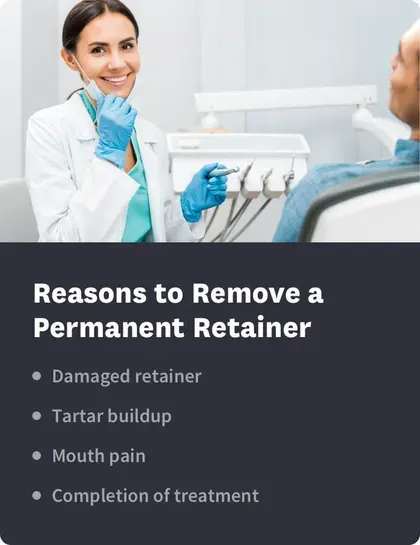Permanent Retainer Removal: Reasons, Procedure & Costs

Table of Contents
- Damaged Retainer
- Tartar Buildup
- Mouth Pain
- Completion of Treatment
- Removing a Permanent Retainer
- Signs That Your Permanent Retainer Needs Removal
- Costs of Permanent Retainer Removal
- Who Can Remove a Permanent Retainer?
- Aftercare Considerations
- Frequently Asked Questions
A permanent retainer is not actually a dental appliance you will keep forever. The permanent label just means that it cannot be removed without the help of an orthodontist or dental professional. While there’s no set time limit on permanent retainers, and some have lasted upward of 20 years, most will need to be removed or replaced after a few years.
Having a fixed retainer removed is generally affordable (around $150 or less without replacement), and the procedure is relatively easy. A dentist or orthodontist will usually simply dissolve the bonding that’s holding the retainer in place, remove the device, and clean and polish the teeth to ensure there is no residue left behind.

What Are Permanent Retainers?
Retainers are used at the end of orthodontic treatment to hold your teeth in place after they have been actively moved by braces or aligners. They can be both removable (the kind you take in and out) or permanent.
Permanent retainers are placed by your orthodontist and “fixed” on the back of your top or bottom teeth.1 These retainers are designed to keep your teeth from shifting out of the position they have been moved into with orthodontic treatment.These retainers often have a lifespan, however. They will usually need to be removed at some point.
Signs That Your Permanent Retainer Needs Removal
Should you look into permanent retainer removal? These reasons could indicate that your device should probably come out:
Damage: You may notice sharp edges on the wire, cuts on your teeth, or blood in your saliva. You may also find bits of adhesive in the sink when you spit after brushing.
Moving: Researchers say some people notice unexplained tooth movement while their retainers are in place. If you notice that your smile looks different than it did when your braces were first removed, it might be time to consider retainer removal.
Dental disease: You can keep your teeth clean with a permanent retainer, but it takes work. You might need special tools to floss around the wire or brushes that can reach behind it. If you notice your gums are bleeding or your dentist mentions dental disease, your retainer might be to blame.
Discomfort: Permanent retainers come in several formats, including thin wires, thick wires, and resin fiberglass. Sometimes, these materials can cut or wear the tongue over time. If you can’t get used to the device, you might consider removing it.
Let’s dig a little deeper into the reasons people consider permanent retainer removal.
Damaged Retainer
Just like with any other dental appliance, a permanent retainer can become damaged or broken. Injury or trauma to the mouth, biting into hard foods, or even general wear and tear can cause wires to snap or brackets to break off the teeth. If this happens, the permanent retainer will need to be taken off.
Your orthodontist will need to see you to determine if the permanent retainer can remain off or if a new one will need to replace the broken one. Your dentist will monitor your permanent retainer during routine checkups to make sure it is not damaged and still functioning as it should be.
Tartar Buildup
The main reason people ask to have a permanent retainer removed is due to tartar buildup. Tartar is plaque that has hardened. It can only be removed through a professional dental cleaning.A permanent retainer can make it more difficult to clean the teeth properly. Tartar, often called calculus, can build up behind it and on your teeth.Ultimately, permanent retainers can complicate oral hygiene practices.2 In some cases, the retainer will need to be removed to clean behind it properly.Left untreated, calculus buildup can lead to tooth decay, cavities, and gum disease. It should be removed by a dental professional as soon as possible.3
Maintaining good oral hygiene — including brushing and flossing your teeth over, behind, and around the permanent retainer — as well as maintaining regular dental appointments can help to prevent the buildup of tartar.
Permanent retainers will need to be removed by an orthodontist. The cost is often included in your orthodontic treatment.
Removing a Retainer Due to Mouth Pain
A retainer is designed to hold your teeth in place after orthodontic treatment. It should not cause the same sort of discomfort that the active stage of braces or clear aligners can when your teeth are moving. Your teeth can continue to shift slightly over time, however, which can cause some strain on the retainer and some mouth pain.
If your retainer is causing tooth pain, see your orthodontist to determine what is going on. They will assess if your permanent retainer needs to be removed or possibly replaced.
Completion of Treatment
A permanent retainer often has a lifespan. After several years of wearing one, your orthodontist may decide that your treatment is complete, and you no longer need to wear one.
Permanent retainers can last as long as 20 years. Some orthodontists will recommend that you wear one as long as possible.
It is important to understand that your teeth can still shift even if your treatment is deemed complete. Often, your orthodontist will recommend that you still use a removable retainer, at least for part of the day or only at night.
Permanent Retainer Removal Cost Considerations
The cost of removing the retainer is usually rolled into your total cost for orthodontic treatment. If it is not part of this plan, the cost for removal can range from $150 to $500. This fee covers the time and expertise of the professional who must remove your retainer.
Some dental professionals charge additional fees, including the following:
Consultations to discuss your retainer, which could cost $50 to $100
X-rays to examine the bones and underlying structures of your teeth, which could cost $50 to $100
Anesthesia to keep you still during removal, which can cost $25 to $50
Where you live can impact your costs too. According to research published in Decisions in Dentistry, states like Delaware, North Dakota, and Alaska are among the most expensive places to visit a dentist. Meanwhile, places like California, Oklahoma, and Kentucky are much less expensive.
You could use your dental plan to cover the cost. Some insurance plans offer coverage for orthodontic work, including retainer placement and removal. Other dental plans explicitly limit their coverage of any kind of tooth-moving work, including device removal.
Who Can Remove a Permanent Retainer?
Only an experienced and trained orthodontist should remove your permanent retainer. The retainer is designed to stay on, so it requires special tools to remove it.
An orthodontist has the tools and equipment required to remove your retainer and ensure the surrounding teeth are healthy and in the proper position. A dentist may also be able to remove your device, but you should check before you make an appointment.
It’s never safe to remove a permanent retainer without a doctor’s help and expertise. Do not try to take off your retainer alone.
Removing a Permanent Retainer
To remove a permanent retainer, your orthodontist will need to remove the bonding cement first with a specialized tool, generally a dental drill. Then, the wires and brackets can be detached. The final step will involve polishing your teeth.
You will need to see your regular dentist to have your teeth properly and professionally cleaned at some point following the removal.
Do not try to remove a permanent retainer on your own without the help of a trained orthodontist. If you are experiencing mouth pain, you notice tartar buildup behind your retainer, or your retainer breaks or becomes damaged, talk to your dentist and orthodontist about your next steps. They will assess whether you are ready to have the permanent retainer completely removed or if you need to have it replaced.
What to Do After the Retainer Is Removed
After your device is removed, your dentist or orthodontist will examine your teeth and gums for damage and create a self-care plan for you. Follow those instructions carefully.
After their fixed retainers come out, most people need to focus on oral hygiene issues. They may be asked to brush and floss more frequently, and their doctor may give them instructions about rinsing their teeth and gums.
If your retainer was removed before your treatment is considered complete, your dentist may suggest a new form of retainer to keep your teeth in place. Clear aligners can serve this purpose, and they’re easy to slip off for dental cleanings. Ask your doctor if this is right for you.
Permanent Retainer Removal Frequently Asked Questions
Some dental professionals include removal costs in your initial retainer fee. If not, expect to pay up to $500 for removal.
Your permanent retainer is attached to your teeth with stiff, hardened glue. Removing that device isn't easy, and dental professionals must do delicate work to get the device out without ruining your other teeth.
You can't remove a permanent retainer without help. Your doctor must use solvents to break down the glue and strip the wire out of your mouth.
Your dentist might recommend removing your permanent retainer due to the following:
Oral hygiene: Poor permanent retainer placement makes flossing and brushing tough. Trapped food and debris can lead to cavities.
Breakage: Even so-called "permanent" retainers must be replaced in time. If yours is broken, loose, or poking you, removal is wise.
Discomfort: You shouldn't feel your permanent retainer. But if you do, removal could be an option.
They can last up to 20 years. If they loosen or come out before then, your orthodontist can reattach it with new glue.
They might. The purpose of the permanent retainer is to keep your teeth in place. Removing it might allow for some shifting. The longer you leave a permanent retainer in, the less likelihood there is for teeth later shifting.
No. Your permanent retainer should only be removed by a dental professional. If you attempt to remove it yourself, you risk permanently damaging your teeth.
